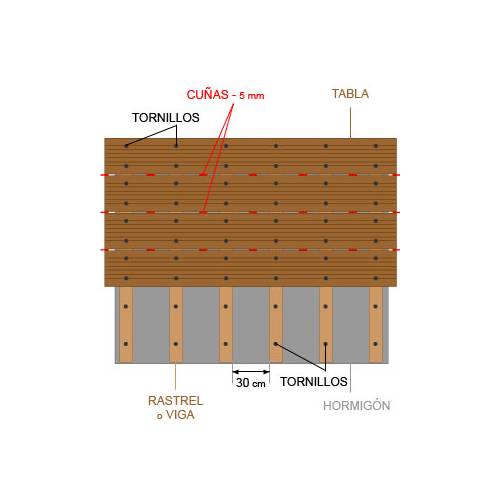
Help for building a wooden terrace
-
What could be more warm and welcoming than a beautiful terrace in wood? The wood used must be pressure treated to class IV, as this will increase its life, or you could use exotic woods such as Ipe, Cumaru or Jatoba that are naturally rot resistant.
Having your terrace built by a professional will end up being very expensive, building the terrace yourself can easily turn it to a disaster if you do not take care and follow the guidelines. In this article you will find the key points that will ensure that your terrace ends up a success.
Before starting it is very important to think about the future terrace. With the help of plans and drawings, visualize your terrace. Do not overlook the small details. Think which way the decking planks will face, mark out the outline of the structure on the ground and consider how high the terrace will be.
Decking planks or duckboards ?
The choice basically depends on how competent you are. It is easier to use duckboards to cover an existing terrace, than to try to lay decking planks. The main problem with duckboards is their square shape, which means that they must fit the size of the terrace.
Laying the decking planks:
To ensure the stability of your terrace and its long life, you will need firstly to create a sturdy structure using joists or beams upon which the planks can be laid.
Non-load bearing beams may be used when the decking planks are used to cover an existing terrace or a concrete base. Fix them using special screws suitable for fixing wood to concrete or use wall plugs knocked into the concrete.
If the structure is to be supported on plastic or concrete feet then it is best to use joists. The bigger these are the more weight they will be able to support, these are known as load bearing.
Use a supporting foot every 40cm for pine decking and every 60cm for exotic wood. The supporting feet must be stable and placed on a solid base so that structure will not move over time.
Beams like the joists need to be parallel, and placed every 30 to 35cm. They should be solidly fixed to the supporting feet.
Once it is established that the joists / beams are level the decking planks can then be fixed to them. Allow a few millimeters between each plank to allow any water to escape easily. Use stainless steel or chromed screws, which are more weather resistant and do not rust.
When laying the planks on exotic wood it is advisable to pre drill the holes for the screws, as this will prevent them from breaking. To finish off your terrace make sure the edges are perfectly straight and build a frame around the edges using some planks of wood to hide the supporting structure.
Buy on-line:
decking planks:
- Exotic hardwood Cumaru
- Exotic hardwood IPE
- Pressure treated pine class IV with knots
- Treated pine class IV small or no knots
Laying:
- Joists and bearers in treated class IV pine
- Adjustable post RONDINOU
- Screw
Building a terrace using duckboards:
Easier to use, duckboard is a lot simpler to lay than decking planks.
The duckboards can be laid directly on to a concrete base. An edging can be built around the duckboards to provide greater stability.
On a solid but uneven base, it is better to use adjustable supporting feet. These should be placed at least every 50cm to guarantee the stability, depending on the size of duckboard used, as shown below:
- A supporting foot in each corner of the duckboard for 40x40 cm or 50x50 cm,
- A supporting foot in each corner and one in the middle of the duckboard for 100x100 cm.
They must be laid on a hard stable base so that the structure does not move over time. Build a frame around the terrace using finishing strips to hide the supporting feet and make it more stable.
Buy on-line:
duckboards:
- Exotic hardwood IPE 40x40
- Exotic hardwood IPE 50x50
- Pressure treated pine class IV 50x50
- Pressure treated pine class IV 100x100
Laying:
- Joists and bearers in treated class IV pine
- Adjustable post RONDINOU
- Screw
Maintenance of a wooden terrace:
Whatever the case a twice yearly clean of your terrace using a brush and water, is a necessity. This will remove any moss and other dirt that has accumulated making the surface slippery.
Regardless of the type of wood used, it is likely to take on greyish tint over time. The use of a high-pressure spray is not advisable as it will change the surface of the wood and make it more fragile. A special product to remove the grey colour should be used regularly (every six months, after cleaning the wood with the brush), this will help restore the original appearance. You could also use a wood treatment after having removed the grey colour, this would also protect the wood and tint it (every couple of years).
If you are happy for your terrace to take on a greyish aspect, then there will be no need to treat the wood further as long as it is already pressure treated class IV. Pressure treated wood should have a life span in excess of 15 years and is already treated against fungal diseases and moss.






